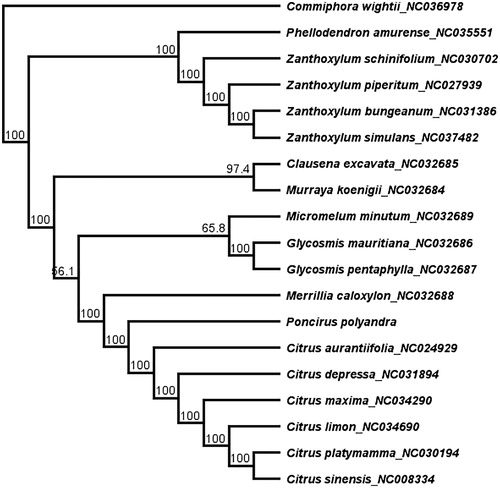Abstract
Poncirus polyandra is a threatened plant in China Now, the complete chloroplast (cp) genome of P. polyandra was assembled. The cp genome of P. polyandra was 160,212 bp in length, it consists of a pair of inverted repeats ((IRa and IRb) regions (27,016 bp) separated by the large single-copy (LSC, 87,407 bp) and small single-copy (SSC, 18,775 bp) regions. The cp genome encodes 105 unique genes, including 70 protein-coding genes, 30 transfer RNA genes, 4 ribosomal RNA genes, and 1 pseudogene. The phylogenetic tree of Rutaceae showed that P. polyandra was clustered together with genus Citrus and Poncirus.
Poncirus polyandra S. Q. Ding et al. is a small evergreen tree, which belongs to the genus Poncirus of the family Rutaceae. The species is known to be sparsely distributed only in limestone habitats of Fuming counties in Yunnan Province of China. In recent years, the natural habitat of P. polyandra is severely damaged by over-exploitation. It is an extremely small population species endemic to Yunnan province. In the present study, applying the Illumina technology, the whole chloroplast genome of P. polyandra was sequenced, assembled, and annotated. Understanding the chloroplast genome information of this rare and endangered tree may provide valuable guidelines for the development of management strategies for both in situ and ex situ conservation activities (Duan et al. Citation2017).
The fresh leaves of P. polyandra were collected from the arboretum of Chinese Academy of Forestry (25.16° N, 102.75° E). The voucher specimen was deposited at Herbarium, Kunming Institute of Botany, CAS (KUN). Total genomic DNA was isolated from fresh leaves using a DNeasy Plant Mini Kit (QIAGEN, Valencia, California, USA) according to the manufacturer’s instructions to construction chloroplast DNA libraries. The Illumina sequencing was conducted by Shanghai Genesky Biotechnologies Inc. (Shanghai, China). Resultant clean reads were assembled using GetOrganelle pipeline (https://github.com/Kinggerm/GetOrganelle). The genome was automatically annotated by using the CpGAVAS pipeline (Liu et al. Citation2012) and start/stop codons and intron/exon boundaries were adjusted in Geneious R11.0.2 (Biomatters Ltd., Auckland, New Zealand). All the contigs were checked against the reference genome of Citrus maxima (NC034290).
The complete cp genome sequence was submitted to the GenBank to get the accession number MK764539 and was 160,212 bp in length. It was the typical quadripartite structure and contained two short inverted repeat (IRa and IRb) regions (27,016 bp) which were separated by a small single copy (SSC) region (18,775 bp) and a large single copy (LSC) region (87,407 bp). The cp genome encodes 105 unique genes, including 70 protein-coding genes, 30 transfer RNA (tRNA) genes, 4 ribosomal RNA (rRNA) genes, and 1 pseudogene. Twenty-one gene species are partially or completely duplicated, including nine PCG (ndhB, ndhF, rpl2, rpsl23, rps7, rps12, rps19, ycf1, and ycf2), seven tRNA (trnI-GAU, trnA-UGC, trnL-CAA, trnI-CAU, trnR-ACG, trnV-GAC, and trnN-GUU), all four rRNA (4.5S, 5S, 16S, and 23S rRNA), and one pseudogene (Ψrpl22). The AT content of the cp genome was 61.6%, while the corresponding values for LSC, SSC, and IR regions were 63.2, 64.8, and 57.1%, respectively.
The chloroplast genome sequences of Rutaceae were downloaded from GenBank and aligned with P. polyandra using MAFFT (Katoh and Standley Citation2013) in Geneious R11.0.2 (Auckland, New Zealand). To resolve its phylogenetic placement within the family Rutaceae, the maximum-likelihood (ML) phylogeny tree was reconstructed using RAxML version 8.1.1179 (Stamatakis Citation2014). Commiphora wightii (NC036978, Burseraceae) was selected as an outgroup. The topology of the phylogenetic tree showed that the species of P. polyandra was clustered together with genus Citrus and Poncirus (). The complete cp genome information reported in this study will be a valuable resource for future studies of the species’ genetic diversity, and the conservation of this highly endangered species.
Disclosure statement
No potential conflict of interest was reported by the authors.
Additional information
Funding
References
- Duan R-y, Huang M-y, Yang L-m, Liu Z-w. 2017. Characterization of the complete chloroplast genome of Emmenopterys henryi (Gentianales: Rubiaceae), an endangered relict tree species endemic to China. Conserv Genet Resour. 9:459–461.
- Katoh K, Standley DM. 2013. MAFFT multiple sequence alignment software version 7: improvements in performance and usability. Mol Biol Evol. 30:772.
- Liu C, Shi L, Zhu Y, Chen H, Zhang J, Lin X, Guan X. 2012. CpGAVAS, an integrated web server for the annotation, visualization, analysis, and GenBank submission of completely sequenced chloroplast genome sequences. BMC Genomics. 13:715.
- Stamatakis A. 2014. RAxML version 8: a tool for phylogenetic analysis and post-analysis of large phylogenies. Bioinformatics. 30:1312.

